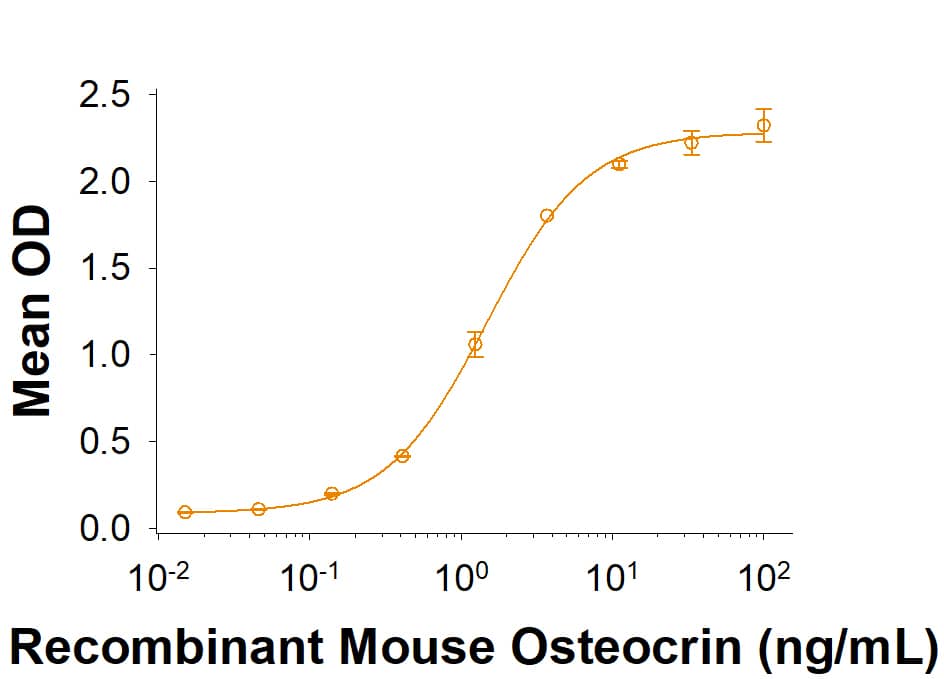Recombinant Mouse Osteocrin Protein, CF
R&D Systems, part of Bio-Techne | Catalog # 9700-ON

Key Product Details
Product Specifications
Source
E. coli-derived mouse Osteocrin protein
Val28-Gly130, with a C-terminal 6-His tag
Val28-Gly130, with a C-terminal 6-His tag
Purity
>95%, by SDS-PAGE visualized with Silver Staining and quantitative densitometry by Coomassie® Blue Staining.
Endotoxin Level
<0.10 EU per 1 μg of the protein by the LAL method.
N-terminal Sequence Analysis
Val28
Predicted Molecular Mass
12 kDa
SDS-PAGE
14-18 kDa, reducing conditions
Activity
Measured by its binding ability in a functional ELISA.
When Recombinant Mouse NPRC/NPR3 Fc Chimera (Catalog # 10187-NR) is immobilized at 2 μg/mL (100 μL/well), the concentration of Recombinant Mouse Osteocrin that produces 50% of the optimal binding response is 0.6-3.6 ng/mL.
When Recombinant Mouse NPRC/NPR3 Fc Chimera (Catalog # 10187-NR) is immobilized at 2 μg/mL (100 μL/well), the concentration of Recombinant Mouse Osteocrin that produces 50% of the optimal binding response is 0.6-3.6 ng/mL.
Scientific Data Images for Recombinant Mouse Osteocrin Protein, CF
Recombinant Mouse Osteocrin Protein Binding Activity
When Recombinant Mouse NPRC/NPR-3 Fc Chimera (Catalog # 10187-NR) is immobilized at 2 µg/mL, Recombinant Mouse Osteocrin (Catalog # 9700-ON) binds with an ED50 of 0.6-3.6 ng/mL.Formulation, Preparation and Storage
9700-ON
| Formulation | Lyophilized from a 0.2 μm filtered solution in PBS. |
| Reconstitution |
Reconstitute at 250 μg/mL in PBS.
|
| Shipping | The product is shipped at ambient temperature. Upon receipt, store it immediately at the temperature recommended below. |
| Stability & Storage | Use a manual defrost freezer and avoid repeated freeze-thaw cycles.
|
Background: Osteocrin
References
- Nishizawa, H. et al. (2004) Journal of Biological Chemistry, 279:19391.
- Thomas, G. et al. (2003) Journal of Biological Chemistry, 278:50563.
- Jeramic N. et al. (2017) J Cell Physiol 232:61.
- Subbatino, E. et al. (2015) Proc. Acad. Natl. Sci. U. S. A. 112:16042.
- Kanai, Y. et al. (2017) J of Clin Invest 127: 4136
- Ataman, B. et al. (2016) Nature 539:242.
Alternate Names
Musclin, OSTN
Gene Symbol
OSTN
UniProt
Additional Osteocrin Products
Product Documents for Recombinant Mouse Osteocrin Protein, CF
Product Specific Notices for Recombinant Mouse Osteocrin Protein, CF
For research use only
